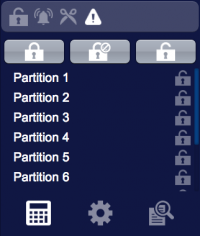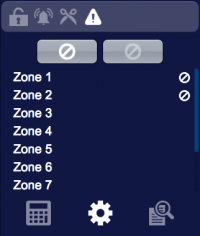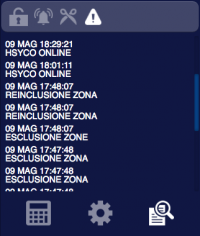Difference between revisions of "Satel"
| Line 834: | Line 834: | ||
=== USER Commands === | === USER Commands === | ||
| − | All writable | + | All writable datapoints can be set from USER commands by setting the '''ID''' field to the corresponding datapoint's ID and the '''Param''' field to the required value. |
== Log Files == | == Log Files == | ||
Revision as of 11:21, 10 May 2016
The Satel INTEGRA series comprises a variety of multi-area security systems. The integration with HSYCO can be accomplished via direct control through Ethernet connection. The I/O Server complies with the protocol INT-RS v2.13 2015-03-19 and has been tested on firmware version 1.14 2015-12-15.
Contents
Satel Configuration
TODO
HSYCO Configuration
Add a SATEL I/O Server in the I/O Servers section of the Settings and set its parameters:
Communication
- IP Address: host name or IP address of the panel
- IP Port: TCP/IP port to use (as configured on the panel)
High Availability
- Shutdown when inactive: defaults to true.
Options
| ID | Default | Values | Description |
|---|---|---|---|
| startupevents | false | true | generate IO events also during the driver’s start-up phase |
| false | start generating events only after HSYCO is aligned with the current status of the system | ||
| logsize | 20 | n ≥ 0 | the number of log lines to display in the UI object |
| usercode | <user_code> | default user code to be used to send commands | |
| maxzone | 1 ≤ n ≤ 256 | highest zone number configured on the panel | |
| maxpartition | 1 ≤ n ≤ 32 | highest partition number configured on the panel | |
| maxoutput | 1 ≤ n ≤ 256 | highest output number configured on the panel | |
| maxdoor | 1 ≤ n ≤ 64 | highest door number configured on the panel |
Datapoints
| ID | Value | R/W | Description |
|---|---|---|---|
| connection | online | R | connection established |
| offline | R | HSYCO can't connect to the panel | |
| armed | 0 | R | all partitions are disarmed |
| 1 | R | the system is (partially) armed | |
| alarm | 0 | R | the system is not in a alarm state |
| 1 | R | the system is in a alarm state | |
| alarm.mem | 0 | R | no active alarm memory |
| 1 | R | the system has an active alarm memory | |
| alarm.fire.mem | 0 | R | no active fire alarm memory |
| 1 | R | the system has an active fire alarm memory | |
| alarm.fire | 0 | R | no fire alarm |
| 1 | R | fire alarm active | |
| alarm.tamper | 0 | R | none of the zone are in tamper alarm |
| 1 | R | at least one zone is in tamper alarm | |
| alarm.tamper.mem | 0 | R | none of the zone have an active tamper alarm memory |
| 1 | R | at least one zone has an active tamper alarm memory | |
| trouble | 0 | R | no trouble |
| 1 | R | active system troubles | |
| trouble.mem | 0 | R | no trouble memory active |
| W | clear trouble memory | ||
| 1 | R | active system trouble memory | |
| service | 0 | R | service mode not active |
| 1 | R | service mode active | |
| time | YYYY-MM-DD hh:mm:ss | R | the date/time set on the panel is the reported one (this datapoint is updated every few minutes unless requested with "read") |
| W | set the specified date/time on the panel | ||
| read | W | requests the reading of the panel date/time | |
| p<n>.name | <text> | R | the name of partition <n> is set to <text> |
| z<n>.name | <text> | R | the name of zone <n> is set to <text> |
| z<n>.open | 0 | R | zone <n> is closed |
| 1 | R | zone <n> is open | |
| z<n>.tamper | 0 | R | zone <n> is not tampered |
| 1 | R | zone <n> is tampered | |
| z<n>.alarm | 0 | R | zone <n> is not in alarm |
| 1 | R | zone <n> is in alarm | |
| z<n>.alarm.tamper | 0 | R | zone <n> is not in tamper alarm |
| 1 | R | zone <n> is in tamper alarm | |
| z<n>.alarm.tamper | 0 | R | zone <n> is not in tamper alarm |
| 1 | R | zone <n> is in tamper alarm | |
| z<n>.alarm.mem | 0 | R | zone <n> does not have an active alarm memory |
| 1 | R | zone <n> has an active alarm memory | |
| z<n>.alarm.tamper.mem | 0 | R | zone <n> does not have an active tamper alarm memory |
| 1 | R | zone <n> has an active tamper alarm memory | |
| z<n>.bypassed | 0 | R | zone <n> is not bypassed |
| W | un-bypass zone <n> | ||
| 1 | R | zone <n> is bypassed | |
| W | bypass zone <n> | ||
| z<n>.trouble | 0 | R | 'no violation' trouble not active on zone <n> |
| 1 | R | 'no violation' trouble active on zone <n> | |
| z<n>.trouble.long | 0 | R | 'long violation' trouble not active on zone <n> |
| 1 | R | 'long violation' trouble active on zone <n> | |
| z<n>.isolated | 0 | R | zone <n> not isolated |
| 1 | R | zone <n> isolated | |
| W | isolate zone <n> | ||
| z<n>.masked | 0 | R | zone <n> not masked |
| 1 | R | zone <n> masked | |
| z<n>.masked.mem | 0 | R | zone <n> does not have an active masked memory |
| 1 | R | zone <n> has an active masked memory | |
| p<n>.armed | 0 | R | partition <n> is not armed |
| W | disarm partition <n> using the default user code if specified in the options | ||
| 1 | R | partition <n> is armed | |
| W | arm partition <n> using the default user code if specified in the options | ||
| 1f | W | force arm partition <n> using the default user code if specified in the options | |
| p<n>.armed.<code> | 0 | W | disarm partition <n> using the specified user code |
| 1 | W | arm partition <n> using the specified user code | |
| 1f | W | force arm partition <n> using the specified user code | |
| p<n>.armed.suppressed | 0 | R | partition <n> is not armed (suppressed) |
| 1 | R | partition <n> is armed (suppressed) | |
| p<n>.armed1 | 0 | R | partition <n> is not armed in mode 1 |
| W | disarm partition <n> in mode 1 using the default user code if specified in the options | ||
| 1 | R | partition <n> is armed in mode 1 | |
| W | arm partition <n> in mode 1 using the default user code if specified in the options | ||
| 1f | W | force arm in mode 1 partition <n> using the default user code if specified in the options | |
| p<n>.armed1.<code> | 0 | W | disarm partition <n> in mode 1 using the specified user code |
| 1 | W | arm partition <n> in mode 1 using the specified user code | |
| 1f | W | force arm partition <n> in mode 1 using the specified user code | |
| p<n>.armed2 | 0 | R | partition <n> is not armed in mode 2 |
| W | disarm partition <n> in mode 2 using the default user code if specified in the options | ||
| 1 | R | partition <n> is armed in mode 2 | |
| W | arm partition <n> in mode 2 using the default user code if specified in the options | ||
| 1f | W | force arm in mode 2 partition <n> using the default user code if specified in the options | |
| p<n>.armed2.<code> | 0 | W | disarm partition <n> in mode 2 using the specified user code |
| 1 | W | arm partition <n> in mode 2 using the specified user code | |
| 1f | W | force arm partition <n> in mode 2 using the specified user code | |
| p<n>.armed3 | 0 | R | partition <n> is not armed in mode 3 |
| W | disarm partition <n> in mode 3 using the default user code if specified in the options | ||
| 1 | R | partition <n> is armed in mode 3 | |
| W | arm partition <n> in mode 3 using the default user code if specified in the options | ||
| 1f | W | force arm in mode 3 partition <n> using the default user code if specified in the options | |
| p<n>.armed3.<code> | 0 | W | disarm partition <n> in mode 3 using the specified user code |
| 1 | W | arm partition <n> in mode 3 using the specified user code | |
| 1f | W | force arm partition <n> in mode 3 using the specified user code | |
| p<n>.open | 0 | R | partition <n> has no open zone |
| 1 | R | partition <n> has open zones | |
| p<n>.alarm.verified | 0 | R | partition <n> has no verified alarm |
| 1 | R | partition <n> has verified alarms | |
| p<n>.warning | 0 | R | partition <n> has no warnings |
| 1 | R | partition <n> has warnings | |
| p<n>.code | 0 | R | partition <n> has 1st code not entered |
| 1 | R | partition <n> has 1st code entered | |
| p<n>.entry | 0 | R | entry time not active on partition <n> |
| 1 | R | entry time active on partition <n> | |
| p<n>.exit.gt10 | 0 | R | exit time on partition <n> not active or not greater than 10 seconds |
| 1 | R | exit time on partition <n> is active and greater than 10 seconds | |
| p<n>.exit.lt10 | 0 | R | exit time on partition <n> not active or not less than 10 seconds |
| 1 | R | exit time on partition <n> is active and less than 10 seconds | |
| p<n>.blocked.temp | 0 | R | partition <n> not temporary blocked |
| 1 | R | partition <n> temporary blocked | |
| p<n>.blocked.guard | 0 | R | partition <n> not blocked for guard round |
| 1 | R | partition <n> blocked for guard round | |
| p<n>.alarm | 0 | R | partition <n> not alarmed |
| 1 | R | partition <n> alarmed | |
| clear | W | clear alarms on partition <n> using the default user code if specified in the options | |
| p<n>.alarm.<code> | clear | W | clear alarms on partition <n> using the specified user code |
| p<n>.alarm.fire | 0 | R | no fire alarm on partition <n> |
| 1 | R | fire alarm on partition <n> | |
| p<n>.alarm.mem | 0 | R | partition <n> does not have an active alarm memory |
| 1 | R | partition <n> has an active alarm memory | |
| p<n>.alarm.fire.mem | 0 | R | partition <n> does not have an active fire alarm memory |
| 1 | R | partition <n> has an active fire alarm memory | |
| o<n>.on | 0 | R | output <n> is off |
| W | switch off output <n> using the default user code if specified in the options | ||
| 1 | R | output <n> is on | |
| W | switch on output <n> using the default user code if specified in the options | ||
| <any_other_val> | W | invert output <n>'s state using the default user code if specified in the options | |
| o<n>.on.<code> | 0 | W | switch off output <n> using the specified user code |
| 1 | W | switch on output <n> using the specified user code | |
| <any_other_val> | W | invert output <n>'s state using the specified user code | |
| d<n>.open | 0 | R | door <n> is closed |
| 1 | R | door <n> is open | |
| W | open door <n> using the default user code if specified in the options | ||
| d<n>.open.<code> | 1 | W | open door <n> using the specified user code |
| d<n>.open.long | 0 | R | door <n> has not been open for a long time |
| 1 | R | door <n> has been open for a long time |
User Interface
Satel Object
The user interface for the Satel multi-area intrusion detection system:
The Satel object is listed in the Project Editor’s new object list only when at least one Satel I/O Server is defined.
Parameters
- server id: the server ID
- position: the object's position. Use the pixels or rows and columns coordinates format
Syntax
(satel <server id>; <position>)
E.g.
(satel serverid; x10y20)
UISET Actions
| ID | Attribute | Set to | |
|---|---|---|---|
| log | value | latest security log lines (as many as specified by the 'logsize' option) | |
| log0 | value | latest line of the security log when a new entry is added, set back to blank after a short period | |
| z<n>.name | value | name assigned to zone <n> | |
| p<n>.name | value | name assigned to partition <n> | |
| connection.offline | visible | true | when datapoint connection = offline |
| false | when datapoint connection = online | ||
| connection.online | visible | true | when datapoint connection = online |
| false | when datapoint connection = offline | ||
| <datapoint_id>.1 | visible | true | when datapoint with ID <datapoint_id> has value '1' |
| false | when datapoint with ID <datapoint_id> has value '0' | ||
| <datapoint_id>.0 | visible | true | when datapoint with ID <datapoint_id> has value '0' |
| false | when datapoint with ID <datapoint_id> has value '1' | ||
USER Commands
All writable datapoints can be set from USER commands by setting the ID field to the corresponding datapoint's ID and the Param field to the required value.
Log Files
If a Satel anti-intrusion unit is connected to HSYCO, the security.log file will be written in the same directories as the daily log files and will include the log entries received by the panel.
This file is never overwritten or deleted from HSYCO SERVER.
Other information about the Satel driver are stored in the message.log daily file.
Release Notes
3.6.0
- initial version release
Satel is a registered trademark of Satel Italia srl.


